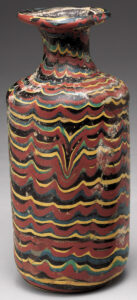
LNS 71 KG
Glass bottle, transparent purple with trailed and marvered pattern in opaque red, yellow, blue and turquoise
Glass objects in the collection date back almost 4,500 years and include objects from virtually every period since. The depth of the glass objects in The al-Sabah Collection allows both scholars and visitors to study, understand and appreciate the evolution of glass techniques from the Bronze Age to 19th century CE.
A stellar example of early glass work can be found on an Achaemenid colourless glass bowl from the late 6th to 5th centuries BCE. The relief-cut rosette, leaf and lotus bud design provides a hint of work to come, presenting a motif that would appear in glass objects even millennia away.
The glassmakers of the Islamic Mediterranean and Iranian regions inherited a rich tradition of techniques and types from their forebears that they were to take in new directions in the mediaeval period.
In Iran the cutting of glass on abrasive wheels continued uninterrupted from the Sasanian period until the 11th century AD. Large numbers of blown glass vessels survive from the earliest period up to the 15th century AD; many of these were blown into metal or ceramic moulds to produce elegant shapes with integral surface decoration..
From the 13th century the glass makers of Syria and Egypt developed a new technique for painting on plain glass vessels. This new type of glass decoration was initially used to produce figural scenes; later a robust calligraphic style was developed, where the entire surface decoration of the likes of mosque lamps and vases is dominated by prominent inscriptions, often further embellished with surface gilding, a style that had never before been seen in glass.

Glass bottle, transparent purple with trailed and marvered pattern in opaque red, yellow, blue and turquoise
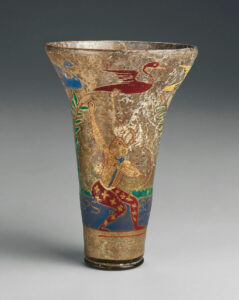
Glass beaker with enamelled and gilded decoration of figures, geese and vegetation
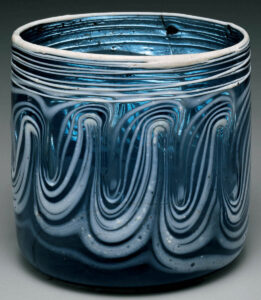
Glass beaker, transparent blue with opaque white trailed and marvered patterns
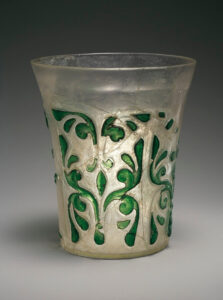
Glass beaker, colorless body, cameo-cut transparent green in a repeating vegetal pattern

Glass bowl, slant-cut in relief with half-palmettes and a winged senmurv creature
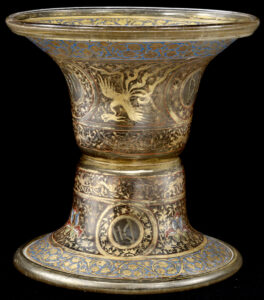
Enamelled glass stand with Mamluk princely blazon, lotuses, phoenixes and bands of quadrupeds

The al-Sabah Collection is rich in manuscripts of the Qur’an. These range from a double page folio from one of the earliest known manuscripts, copied in the second century of Islam in a distinctive vertical script known as Hijazi, to

Ceramics is one of the oldest industries, dating back to the Paleolithic era, more than 30,000 years ago. While The al-Sabah Collection is rich in ceramics, the primary focus of the collecting effort concentrated on covering the range of different
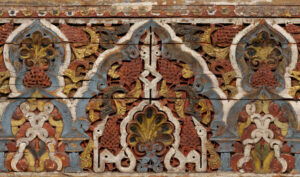
Objects of ivory and wood comprise decorative architectural items such as beams and doors, and smaller items such as boxes, jewellery and gaming pieces. Relatively few examples have survived due to the perishability of the materials.
That said, an ivory